Raevenlord
News Editor
- Joined
- Aug 12, 2016
- Messages
- 3,755 (1.21/day)
- Location
- Portugal
| System Name | The Ryzening |
|---|---|
| Processor | AMD Ryzen 9 5900X |
| Motherboard | MSI X570 MAG TOMAHAWK |
| Cooling | Lian Li Galahad 360mm AIO |
| Memory | 32 GB G.Skill Trident Z F4-3733 (4x 8 GB) |
| Video Card(s) | Gigabyte RTX 3070 Ti |
| Storage | Boot: Transcend MTE220S 2TB, Kintson A2000 1TB, Seagate Firewolf Pro 14 TB |
| Display(s) | Acer Nitro VG270UP (1440p 144 Hz IPS) |
| Case | Lian Li O11DX Dynamic White |
| Audio Device(s) | iFi Audio Zen DAC |
| Power Supply | Seasonic Focus+ 750 W |
| Mouse | Cooler Master Masterkeys Lite L |
| Keyboard | Cooler Master Masterkeys Lite L |
| Software | Windows 10 x64 |
Intel today tried to burn the entire hardware media world with a flurry of announcements designed to make our fingers bleed. Alongside their mainstream desktop 9th generation series which goes up to the mainstream overclocker's dream i9-9900K (which is now available for pre-order on Amazon from $499), Intel also announced a new HEDT lineup in the form of the 9th Gen Core X series, which are still being fabbed on their 14 nm++ nodes.
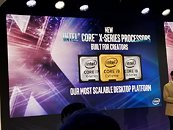
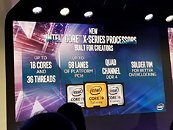
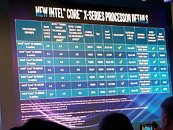
The Core X series comes as an answer to AMD's Threadripper-based HEDT lineup - which still wins in core-counts alone by an almost ungodly margin. However, Intel likes to put it this way: better fewer, stronger cores than more numerous, weaker ones. The new lineup spans the i7-9800X with its 8 cores and 16 threads running at 3.8 GHz base clocks with 16.5 MB of L3 cache all the way to the 18-core, 36-thread i9-9980XE, which runs at 3 GHz base clocks with 24.75 MB of L3 cache. Intel is also deploying their Turbo Boost Max tech which will allow its new CPUs to achieve higher boost clocks than with their Turbo Boost 2.0 - by 100 MHz. All Intel CPUs - from the 8 to the 18-core - feature a 165 W TDP, and will slot in on LGA 2066, X299 motherboards (don't forget your BIOS updates, though).
The new HEDT processors and Core X series supports quad-channel DDR4 memory, at a base speed of 2666 MHz - but as we all know, Intel platforms have been extremely apt in taking the most out of maximum DDR4 memory frequency. The new processors do away with one of the harshest criticisms that has been thrown Intel's way on how they handle their enthusiast or overclocking-geared CPUs - they've finally gotten rid of their TIM paste interface, and opted for soldering their CPUs for better thermal characteristics (and ultimately, higher clockspeeds/stability). Of course, now the company goes on to say what we all knew - that solder improves on performance achieved by TIM paste solutions. And even goes so far as using this change as a selling point. Oh, Intel.
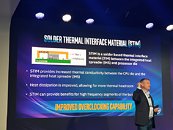
All new CPUs in the Core X series deliver up to 68 PCIe 3.0 lanes (44 delivered by the CPUs themselves, less than the 64 AMD's CPUs provide) and an additional 24 delivered by their PCH. Core X chips include hardening (both in silicon and microcode updates) against both Spectre and Meltdown vulnerabilities. And Intel delivered some performance numbers with their presentation, claiming 27% faster 3D rendering, 107% faster video editing, and 13% faster game build time (always up to, and always pitting Intel's $1,979 18-core, 36-thread i9-9980XE against AMD's $1990, 32-core, 64-thread Threadripper 2990WX).
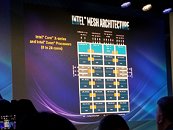
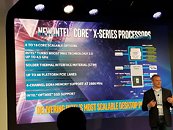

Interestingly, from an architecture perspective, Intel is carving these new CPUs from three different dies: LCC (low core count) and HCC (high core count), with the LCC die covering anything from 4-10 cores and the HCC die covering up to 18 cores. The L3 cache on these is of the non-inclusive, victim type - it only loads data that had already been discarded from the L2 cache for other, more priority-heavy data.
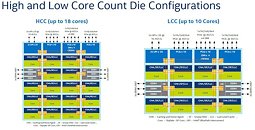
View at TechPowerUp Main Site



The Core X series comes as an answer to AMD's Threadripper-based HEDT lineup - which still wins in core-counts alone by an almost ungodly margin. However, Intel likes to put it this way: better fewer, stronger cores than more numerous, weaker ones. The new lineup spans the i7-9800X with its 8 cores and 16 threads running at 3.8 GHz base clocks with 16.5 MB of L3 cache all the way to the 18-core, 36-thread i9-9980XE, which runs at 3 GHz base clocks with 24.75 MB of L3 cache. Intel is also deploying their Turbo Boost Max tech which will allow its new CPUs to achieve higher boost clocks than with their Turbo Boost 2.0 - by 100 MHz. All Intel CPUs - from the 8 to the 18-core - feature a 165 W TDP, and will slot in on LGA 2066, X299 motherboards (don't forget your BIOS updates, though).
The new HEDT processors and Core X series supports quad-channel DDR4 memory, at a base speed of 2666 MHz - but as we all know, Intel platforms have been extremely apt in taking the most out of maximum DDR4 memory frequency. The new processors do away with one of the harshest criticisms that has been thrown Intel's way on how they handle their enthusiast or overclocking-geared CPUs - they've finally gotten rid of their TIM paste interface, and opted for soldering their CPUs for better thermal characteristics (and ultimately, higher clockspeeds/stability). Of course, now the company goes on to say what we all knew - that solder improves on performance achieved by TIM paste solutions. And even goes so far as using this change as a selling point. Oh, Intel.

All new CPUs in the Core X series deliver up to 68 PCIe 3.0 lanes (44 delivered by the CPUs themselves, less than the 64 AMD's CPUs provide) and an additional 24 delivered by their PCH. Core X chips include hardening (both in silicon and microcode updates) against both Spectre and Meltdown vulnerabilities. And Intel delivered some performance numbers with their presentation, claiming 27% faster 3D rendering, 107% faster video editing, and 13% faster game build time (always up to, and always pitting Intel's $1,979 18-core, 36-thread i9-9980XE against AMD's $1990, 32-core, 64-thread Threadripper 2990WX).



Interestingly, from an architecture perspective, Intel is carving these new CPUs from three different dies: LCC (low core count) and HCC (high core count), with the LCC die covering anything from 4-10 cores and the HCC die covering up to 18 cores. The L3 cache on these is of the non-inclusive, victim type - it only loads data that had already been discarded from the L2 cache for other, more priority-heavy data.

View at TechPowerUp Main Site



